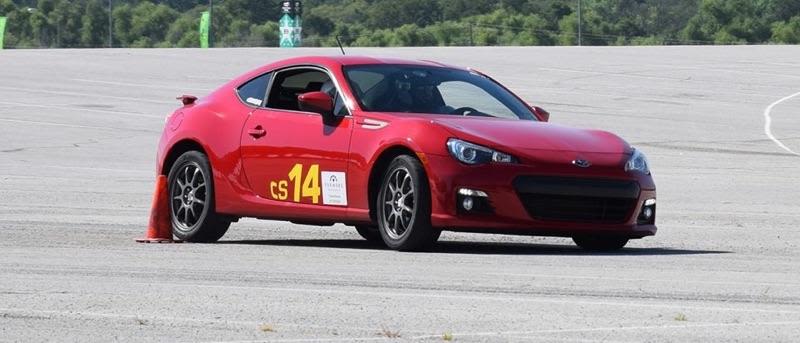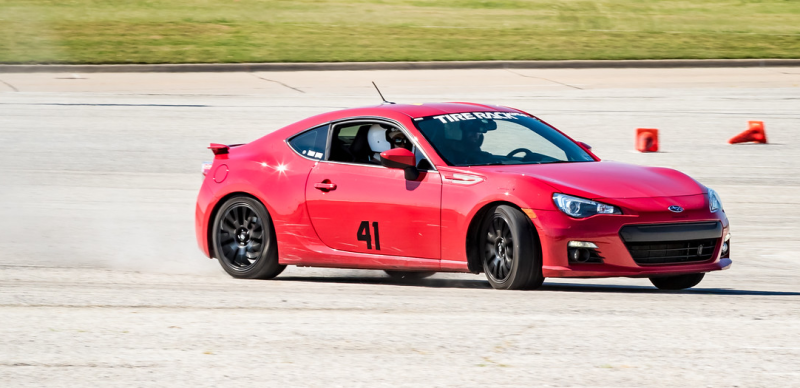
This is part III of an ongoing series about how to go to and get faster at the track. Parts I and II can be found here:
The only part of your car that touches the ground are your tires. Managing your tires’ grip is the key to driving quickly around the track. By maximizing and fully utilizing all the available grip you will be able to go as fast as possible. Your car is balanced on its suspension and by moving the weight to where you need when you need it you can maximize the tires’ grip.
Weight is transferred to the front tires whenever you slowdown (brake or lift off the throttle) and the faster you slow the more weight is transferred. Since the front tires are the ones responsible for turning, you want to transfer as much weight as possible to the front tires just before the turn. Do your braking late and hard just before the turn then when you turn in, smoothly lift off the brake. As the front of the car turns in, the rear will begin to rotate as well and if you’ve transferred too much weight to the front, the rear will over rotate (over steer).

As you turn a few things happen: first, weight is transferred from the inside to the outside tires; second, the rear of the car begins to pivot and rotate; and third, the front tires are pushed sideways and this tire scrub slows the car which also increases weight transfer from the rear to the front. How the car reacts and what happens next depends on which tires lose grip first. If all 4 tires start to slide at the same time, the car slides outwards in a 4-wheel drift until the radius of the turn has increased to match the limit of your available grip or you slow down enough to fall below the limits of the available grip. If you go into a 4-wheel drift, congratulations you’ve found the limits of grip.
If the front tires lose grip first, the car will start to understeer as the front tires slide sideways. The natural reaction to understeer is to turn the steering wheel more, but this will only make the understeer worse. Instead, unwind the steering wheel (turn less). This allows the direction of rotation of the tire to align better with the direction of travel of the car. Rolling tires have more grip than sliding tires (because physics), so as you unwind the wheel the car will turn better. To avoid understeer you need to either increase the grip of the front tires or decrease the amount of grip you need from them (go slower or take a wider line). One way to increase the grip of the front tires is to transfer more weight to them. Often, you can make your car turn in better by lifting, or braking before the corner. This will work until the rears start to lose grip and slide (remember, that’s where the weight and extra grip came from).
When the rear tires lose grip first, the car will start to over steer and slide sideways. Since the front tires still have grip, they will act as a pivot point and the back of the car will try to rotate around them (spin). To correct over-steer, you need to use some opposite lock (counter steer) and turn the wheel into the slide (towards the outside of the corner). This will straighten out the car and allow the rear tires to regain some grip. Since the rears lost grip, the last thing we want to do is to further reduce their grip by lifting or braking and transferring weight away. One option is to transfer less weight to the front by either staying on the throttle or brake more softly, if you get mid-corner over steer you can start using some maintenance throttle (partial throttle to balance out the wight transfer and move some weight to the rear tires). If you’ve over stressed the rears by stomping on the gas, just more smoothly add throttle and ease onto the gas instead of using it like an on/off switch.
There’s an old saying in racing “slow is smooth and smooth is fast.” Your hands should move deliberately and your feet should move in single strokes. The better a driver someone is, the slower it looks like they are doing things. They steer fewer times, they use the pedals just once for each section of a corner, and the only thing they do fast is shift. These smooth inputs will help keep the car balanced, just like if you were standing and someone progressively pushed harder on you, you could compensate and retain your balance so too will the car better adjust to progressive inputs made smoothly. The same applies to how you release the brakes, an often overlooked portion of the braking event, you foot should smooth release the brake to progressively shift weight from the front to the rear of your car.
Many drivers will think they are going as fast as fast as possible around a corner because they start to slid, only to learn that their jerky inputs have artificially lowered the limits and are slowing them down. If you focus on shifting the car’s weight where you want it, you will be able to go faster.